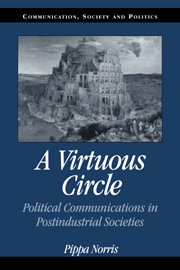Book contents
- Frontmatter
- Contents
- List of Tables
- List of Figures
- Preface
- PART I THE NEWS MEDIA AND CIVIC MALAISE
- PART II TRENDS IN POLITICAL COMMUNICATIONS
- 4 The Decline of Newspapers?
- 5 The Rise (and Fall?) of the Television Age
- 6 The Emerging Internet Era
- 7 The Evolution of Campaign Communications
- 8 The Rise of the Postmodern Campaign?
- PART III THE IMPACT ON DEMOCRACY
- CONCLUSIONS
- Technical Appendix
- Notes
- Select Bibliography
- Author Index
- Subject Index
7 - The Evolution of Campaign Communications
Published online by Cambridge University Press: 26 February 2010
- Frontmatter
- Contents
- List of Tables
- List of Figures
- Preface
- PART I THE NEWS MEDIA AND CIVIC MALAISE
- PART II TRENDS IN POLITICAL COMMUNICATIONS
- 4 The Decline of Newspapers?
- 5 The Rise (and Fall?) of the Television Age
- 6 The Emerging Internet Era
- 7 The Evolution of Campaign Communications
- 8 The Rise of the Postmodern Campaign?
- PART III THE IMPACT ON DEMOCRACY
- CONCLUSIONS
- Technical Appendix
- Notes
- Select Bibliography
- Author Index
- Subject Index
Summary
Many accounts have noted the decline of traditional forms of party campaigning, such as local rallies and door-to-door canvassing, and new developments like the growth of spin-doctors and political consultants. A growing series of case studies has documented these trends in a range of established and newer democracies. Different accounts have interpreted these changes in various ways: as the ‘rise of political marketing’, if the techniques have been borrowed from the private sector, or as the'Americanization of campaigning’, if these forms of electioneering originated in the United States. Building upon this literature, the core argument of this chapter is that such changes in campaign communications can best be understood as evolutionary processes of modernization that simultaneously transform party organizations, the news media, and the electorate. This typology is illustrated schematically in Table 7.1 and Figure 7.1.
In this theoretical framework, premodern campaigns are understood as having three basic characteristics: The campaign organization is based upon direct forms of interpersonal communications between candidates and citizens at the local level, with short-term, ad-hoc planning by the party leadership. In the news media, the ‘partisan press’ acts as core intermediary between parties and the public. And the electorate is anchored by strong party loyalties. During this era, local parties selected the candidates, rang the doorbells, posted the pamphlets, targeted the wards, planned the resources, and generally provided all the machinery linking voters and candidates. For citizens, the model is one that is essentially local-active, meaning that most campaigning is concentrated within local communities, conducted through relatively demanding political activities like rallies, doorstep canvassing, and party meetings.
- Type
- Chapter
- Information
- A Virtuous CirclePolitical Communications in Postindustrial Societies, pp. 137 - 161Publisher: Cambridge University PressPrint publication year: 2000
- 3
- Cited by



